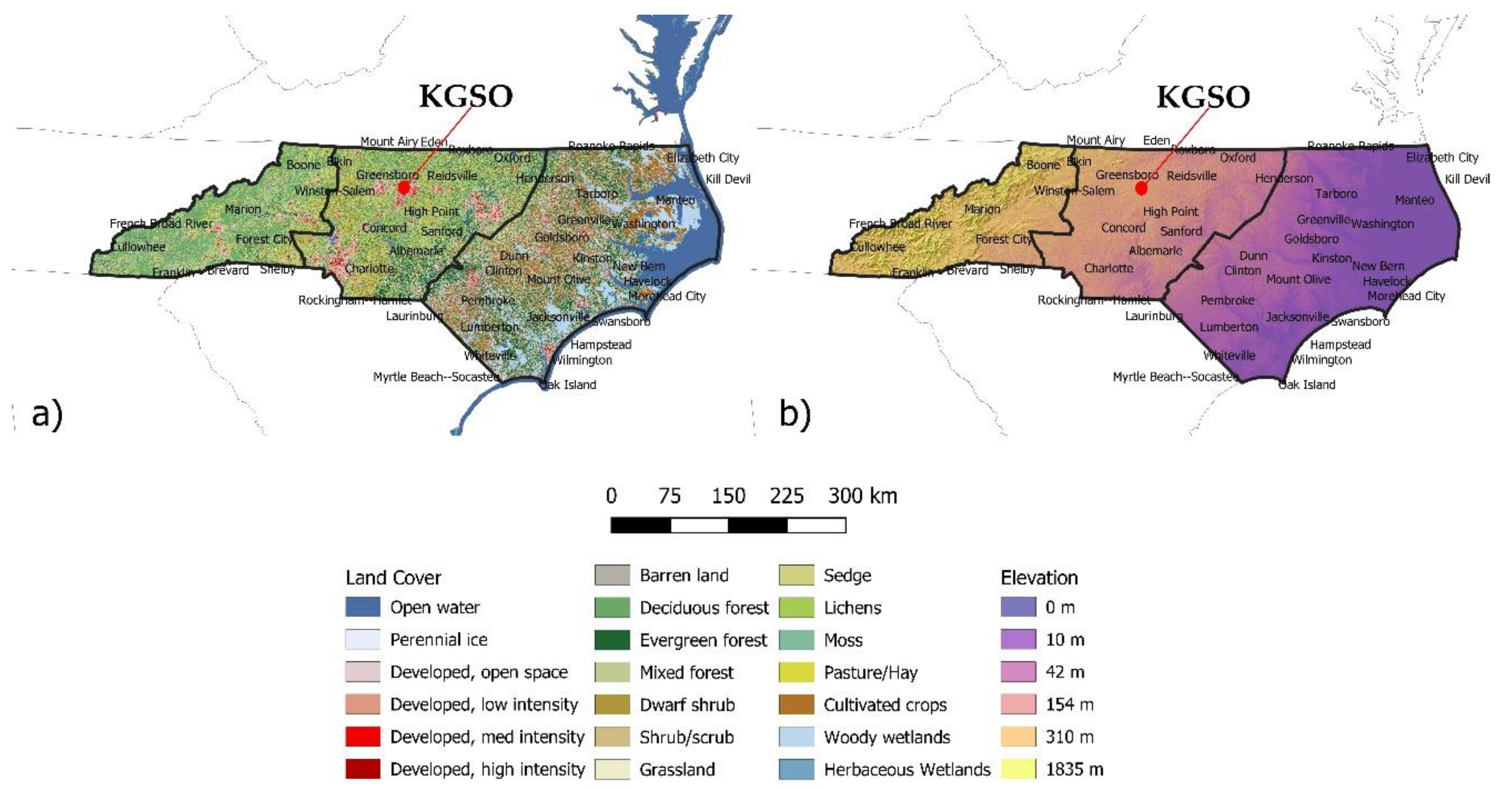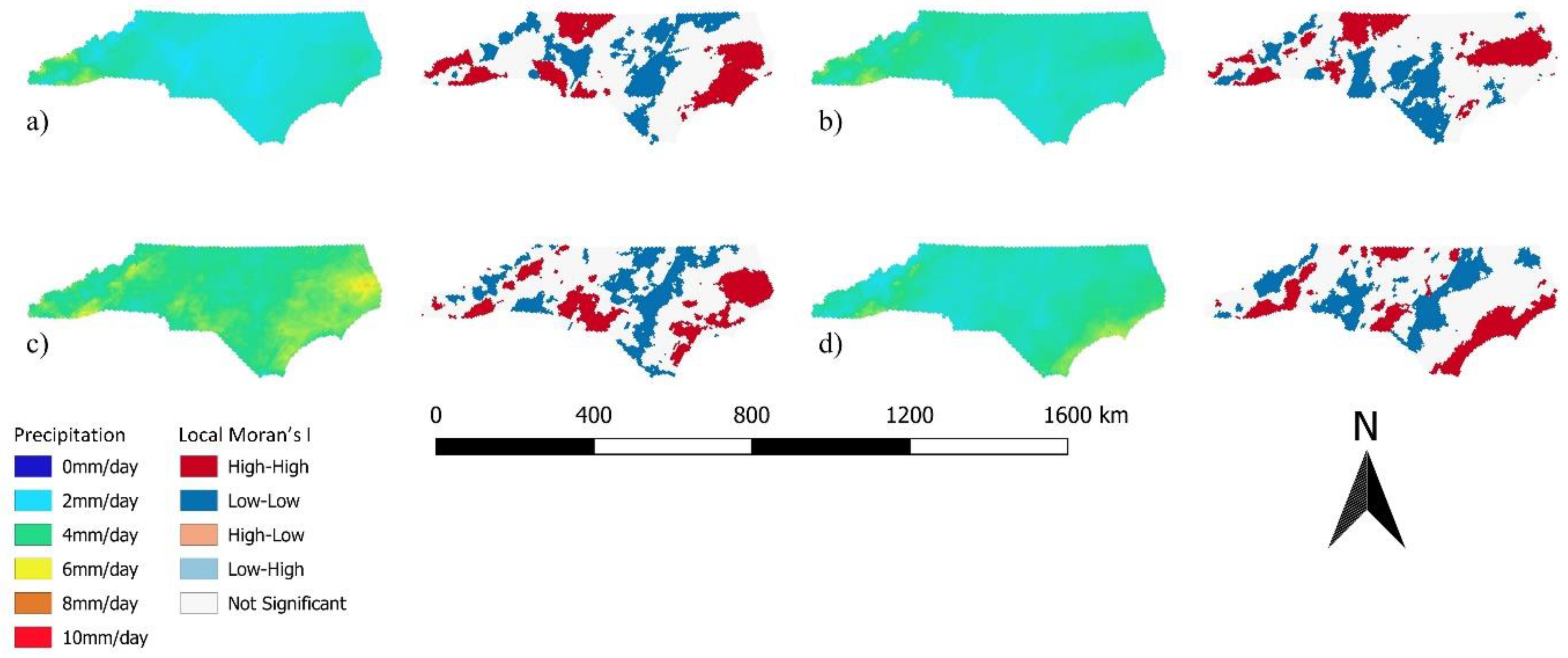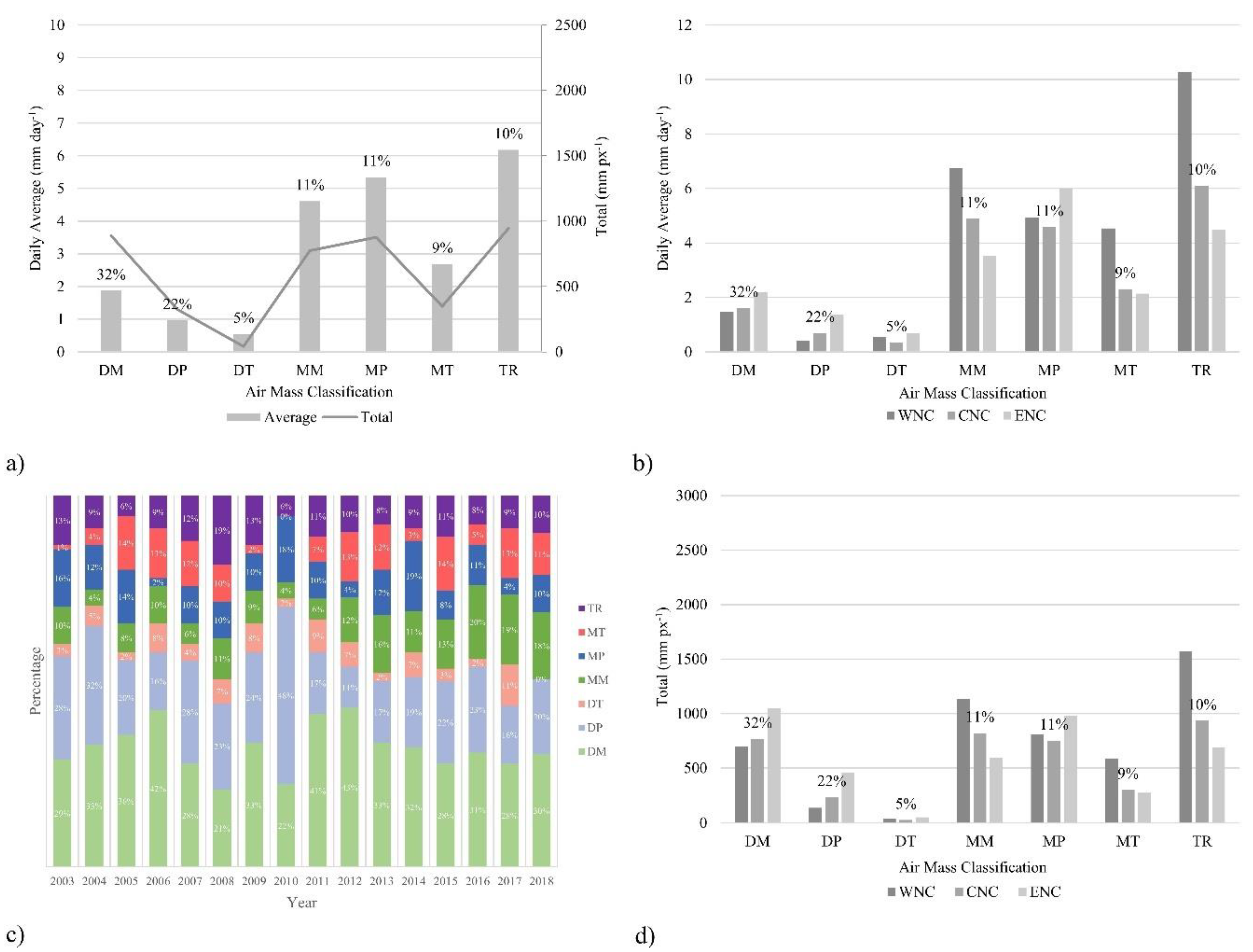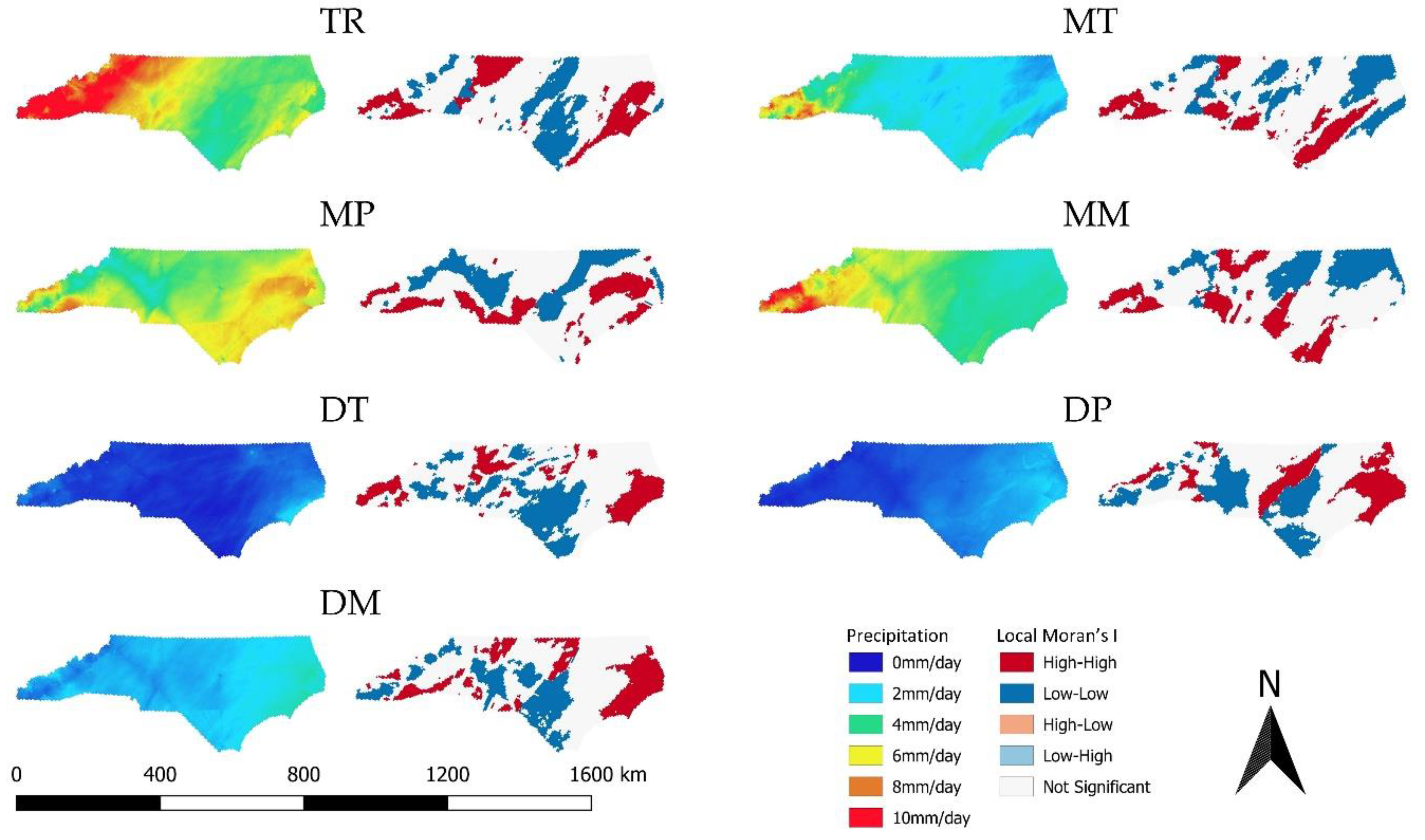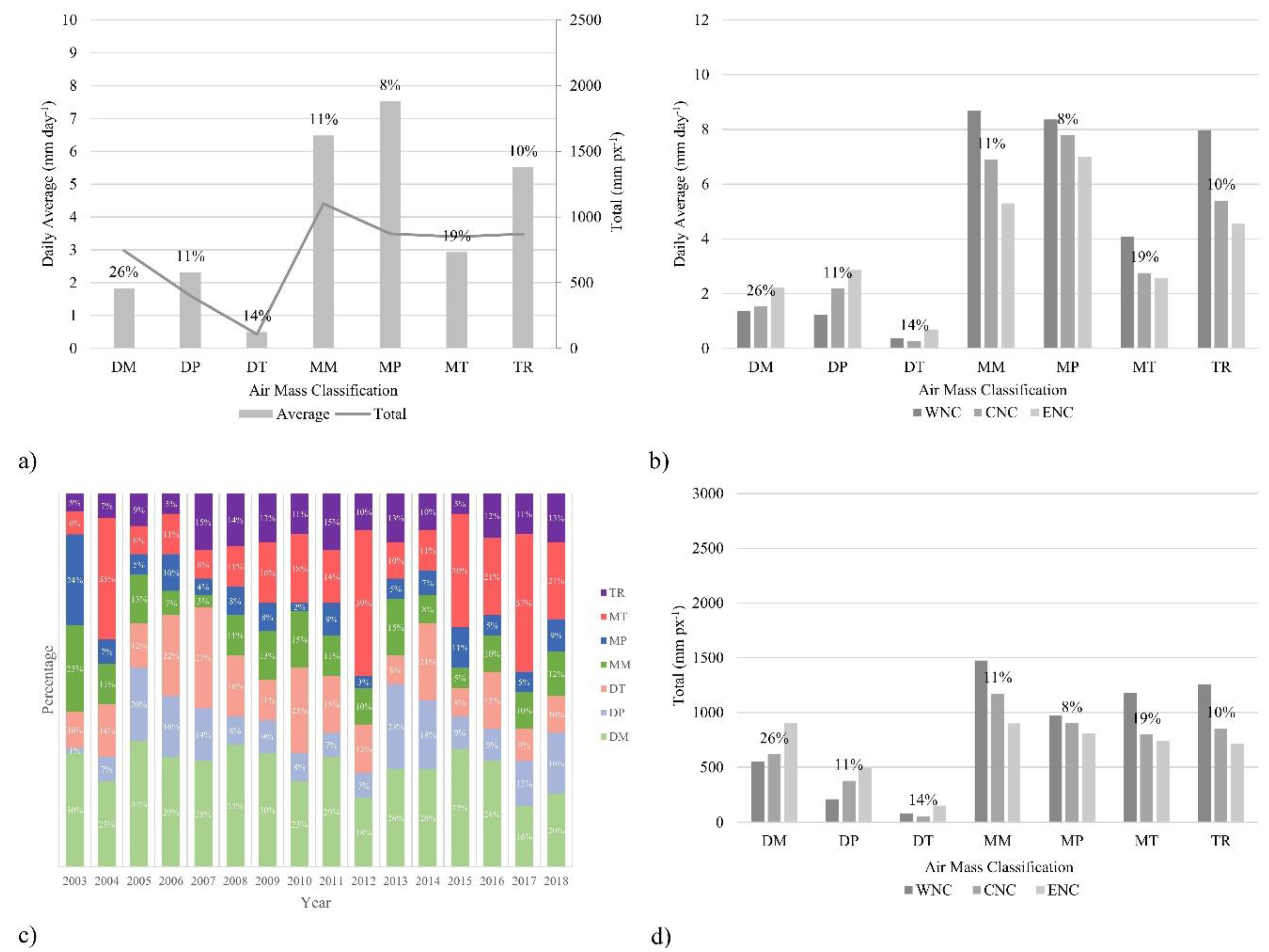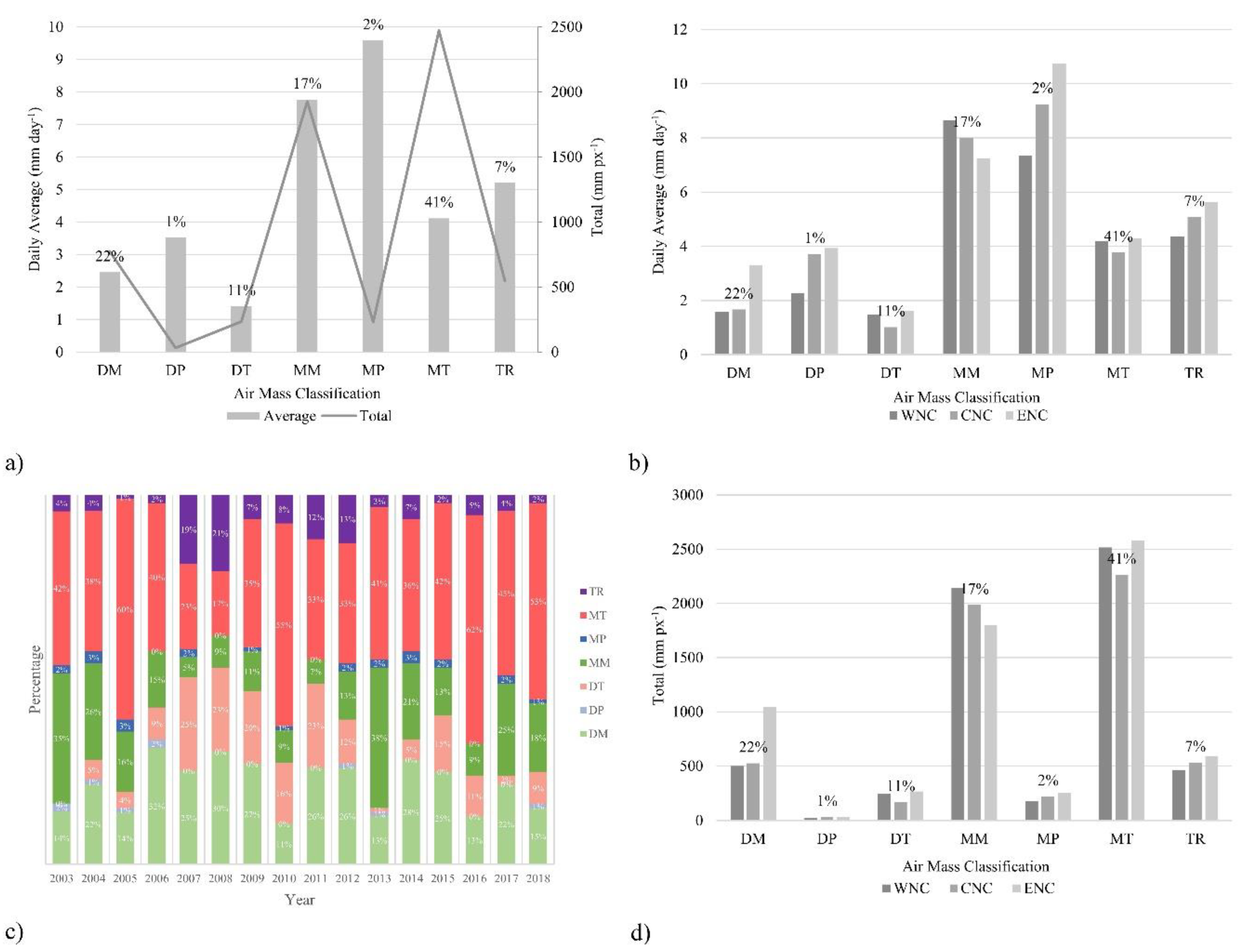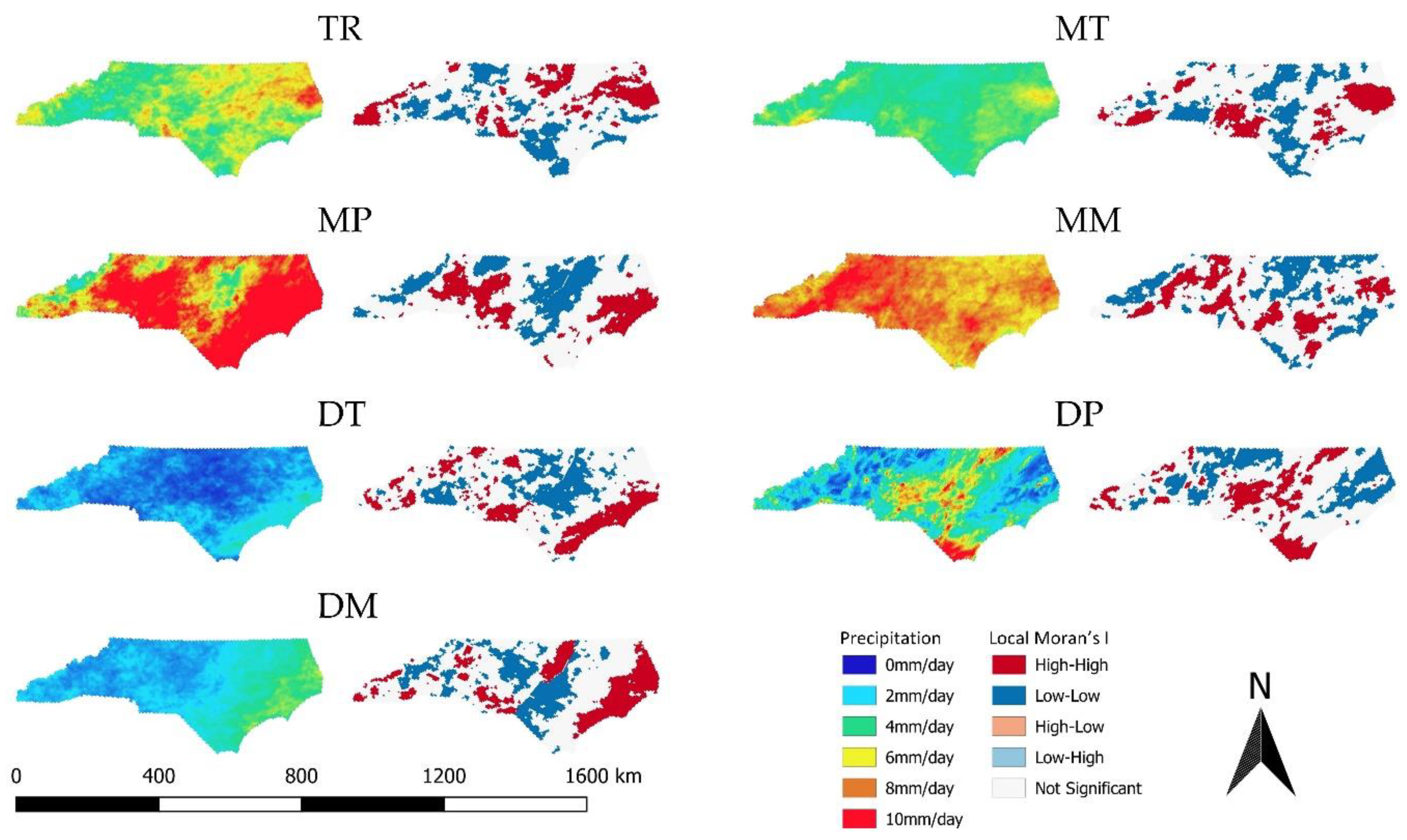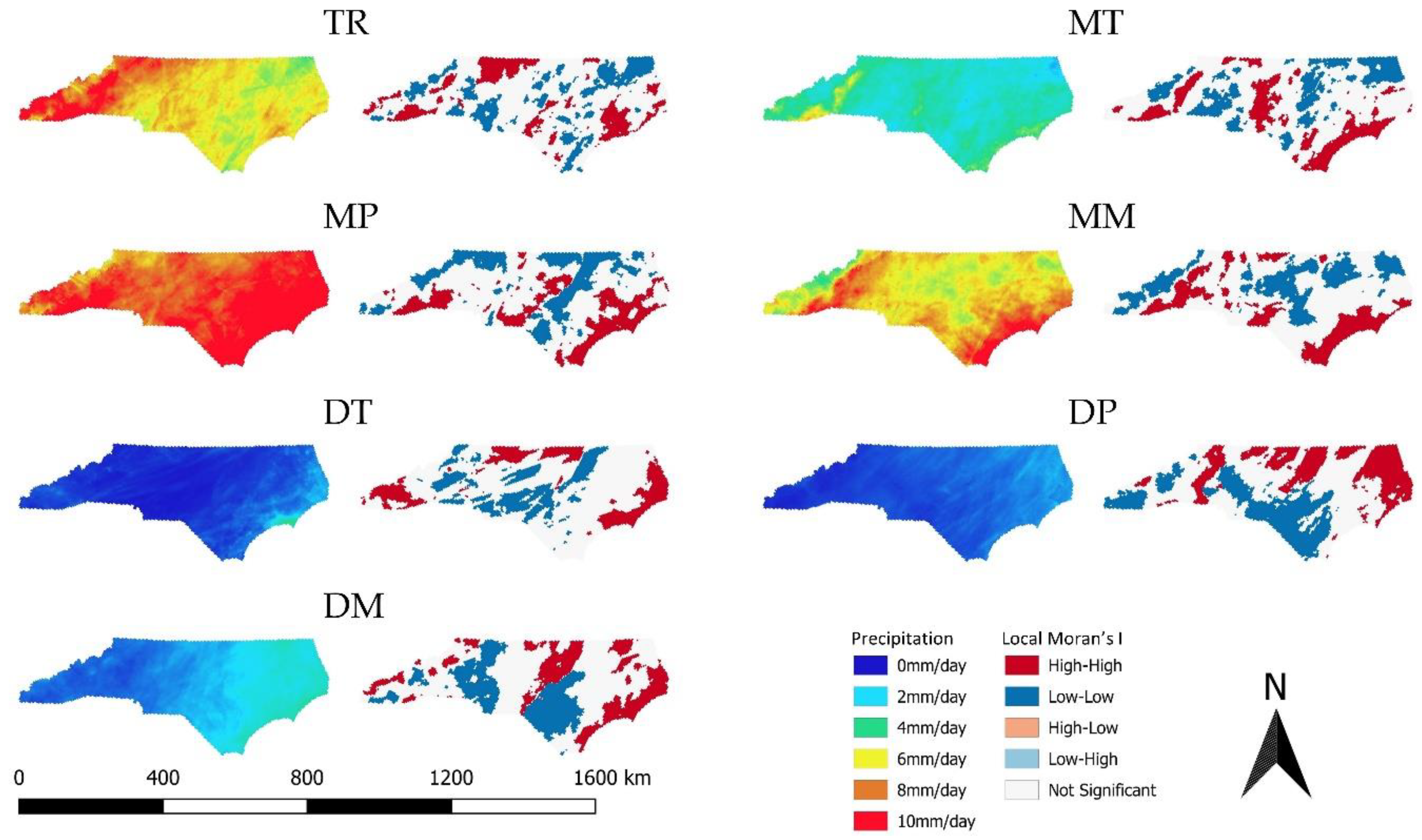1. Introduction
Knowledge of precipitation variability is essential for improving the forecasting and mitigation of hydrological hazards. Rapid population growth and increasing urban density act both to exacerbate human susceptibility to hydrological hazards and increase precipitation sensitivity to anthropogenic modifications to surface land cover conditions and climate change [
1]. This is especially true in the Southeast United States, which is home to some of the faster growing areas in the United States [
2].
Precipitation in the southeastern United States has strong seasonal and regional sensitivity due to variations in mid-latitude cyclone frequency [
3], tropical cyclones [
4], orographic processes [
5], sea breeze circulations [
6], and local-scale thermodynamic forcing [
7]. Analyses of long-term precipitation patterns and trends over the Southeast United States tend to rely on dense rain-gauge networks [
8,
9], although such data sources often have poor spatial coverage. Passive satellite remote sensing platforms have been used to explore the spatial characteristics of precipitation, especially around large metropolitan areas [
10]; however, because precipitation distribution is known to vary with scale [
11], studies have more recently used fine temporal and spatial radar-derived precipitation estimates for the analysis of spatio–temporal precipitation patterns at greater detail [
12]. Furthermore, radar coverage in the Southeast United States has been shown to reproduce precipitation observations comparable to surface gauges [
13,
14]. The advent of radar-based multi-sensor precipitation datasets has further improved the accuracy of radar-based precipitation estimates. These multi-sensor datasets augment radar data with surface rain gauge and satellite precipitation estimates to address the caveats associated with radar estimates, especially over complex terrain. While these types of data and algorithms are becoming more viable for scientific analysis due to longer periods of record, the application of these multi-sensor precipitation data in characterizing long-term precipitation patterns across the Southeast United States has been infrequent [
15,
16].
Precipitation in the cool season tends to be associated with the passage of mid-latitude cyclones [
3], while warm-season precipitation is often linked with local-scale thermodynamic forcing induced by variations in land cover and soil characteristics [
6,
17] and tends to occur in the late afternoon and evening [
18]. In a long-term study over North Carolina, Sayemuzzaman and Jha [
9] noted that the majority of North Carolina rain gauge stations experienced a negative trend in wintertime precipitation and a positive trend in summertime precipitation. These seasonal precipitation trends may indicate a shift from more homogenous synoptically driven precipitation events to more heterogeneous thermodynamically driven precipitation events, which would have important implications for stormwater management, water resource allocation, and agricultural operations. Furthermore, there has been a notable increase in the urban heat island signal across the central portion of North Carolina [
19]. The combined effect of increasing summertime precipitation and increasing urban heat island signals points toward more intense and spatially heterogeneous precipitation patterns [
20,
21]; however, the magnitude of this signal will be dictated by the prevailing synoptic-scale air mass. For example, a seasonal shift in days under dry polar (DP) air mass regimes to days under moist tropical (MT) air mass regimes would enhance the thermodynamic forcing of precipitation by increasing the surface energy fluxes [
22].
The objective of this study is to quantify the spatial and temporal patterns of precipitation across North Carolina, USA in relation to synoptic-scale air mass classification. North Carolina is a unique natural laboratory for studying precipitation because of the distinct geographic features separating three regions across the state, and because of natural variability in annual and seasonal precipitation regimes. The presented analysis uses multi-sensor data from the National Center for Environmental Prediction (NCEP) to define spatial precipitation patterns over a 16-year period (2003–2018). In addition to studying the seasonal spatial variability in precipitation, this paper will place the analysis in the context of prevailing air mass conditions to investigate how variations in synoptic-scale forcing, or lack thereof, influence seasonal precipitation regimes across the study domain. This will be important for the forecasting and mitigation of hydrological hazards, especially in response to rapid population growth and urbanization across North Carolina.
2. Materials and Methods
North Carolina offers a unique natural laboratory because it displays a large variety of topographic, soil type, and land use characteristics, including mountainous terrain, dense forests, agricultural lands, metropolitan cities, and low relief coastal regions (
Figure 1).
The state is comprised of three geologically distinct regions. Western North Carolina (WNC) is characterized by complex terrain in the Appalachian Mountains covered by a mix of deciduous forests and boreal conifer forests with thick underbrush, as well as a sparse matrix of urban regions. The Piedmont region of central North Carolina (CNC) is a dramatic transition in both vegetation and soil characteristics from the western mountains to the eastern coastal lowlands. CNC transitions from the WNC deciduous and conifer forests to heavy agricultural and urban land cover, and has the highest population density and fastest population growth of the three regions, leading to an increasing trend in impervious surfaces [
19,
23]. The Coastal Plains in eastern North Carolina (ENC) are characterized by sparsely populated cities, widespread livestock operations, and hardwood swamp forests in the eastern coastal lowlands.
The current study utilized 16 years (2003–2018) of the NCEP Stage IV multi-sensor precipitation estimates product [
24]. The NCEP Stage IV product is produced by mosaicking twelve National Weather Service (NWS) River Forecast Center (RFC) hourly Next Generation Weather Radar (NEXRAD) Stage III/Multi-sensor Precipitation Estimator (MPE) products [
25]. The Stage III/MPE product is a radar-based precipitation dataset that combines ground and space-derived precipitation estimates and is quality controlled at each RFC. As such, the final Stage IV product produces hourly and daily best estimate gridded precipitation products projected on the Hydrologic Rainfall Analysis Project (HRAP) polar stereographic coordinate system centered at 60° N/105° W with a nominal 4 × 4 km grid resolution. Nelson [
26] noted concerns using the hourly estimates due to the automated hourly quality control procedures used at RFCs; therefore, the manually quality controlled daily NCEP Stage IV gridded binary (GRIB I) product was used in the current study.
The spatial synoptic classification (SSC) [
22] data from the Greensboro station (KGSO) were used to identify the prevailing air mass conditions for each day in the dataset. KGSO was selected because it is a centrally located SSC site in North Carolina and is representative of the prevailing air mass conditions over all three regions. While air mass extents are generally accepted to be larger than the state of North Carolina, it was necessary to justify the viability of using a single, centrally located site. After running a correlation between the Asheville, NC, Greensboro, NC, and Hatteras, NC SSC sites, the results showed moderate agreement. Furthermore, air mass types along the coast would be less variable due to higher station humidity level, while the air mass conditions over the mountains would be highly variable, especially considering the air mass is defined by site specific conditions. As a result, a location in the center of the state was identified as the most representative of the general regional air mass conditions.
Classification of the different air masses by the SSC developed by Sheridan [
22] first identified baseline conditions at each site by selecting seed days that described typical meteorological characteristics during each air mass condition, including temperature, dew point depression, mean cloud cover, mean sea level pressure, diurnal temperature range, and diurnal dew point range. With the SSC system, it is possible to classify the prevailing air mass into one of seven categories: transitional (TR), moist tropical (MT), moist moderate (MM), moist polar (MP), dry tropical (DT), dry moderate (DM), and dry polar (DP) (
Table 1). For example, many urban heat island studies focus on MT days because this air mass is typically associated with synoptically benign days that experience conditional instability conducive to thermodynamically driven convection [
20,
21,
22,
27]. Additional details on the development of the SSC dataset are provided by Sheridan (
http://sheridan.geog.kent.edu/ssc.html, [
22]). In the current study, we incorporated all classifications to consider the impact of the prevailing air mass on seasonal spatial and temporal precipitation patterns.
The NCEP Stage IV data were subset seasonally and by air mass. Statewide and regional values were extracted to calculate the daily average and total precipitation within the respective areas. Daily average precipitation represents the average daily precipitation that fell at each pixel contained within the respective area. The total precipitation is presented in units of millimeter per pixel because it represents the total accumulated precipitation averaged across all pixels contained within each respective area. Averaging total precipitation across the respective area rather than adding precipitation accumulation of each grid cell (i.e., pixel) allowed for the comparison of precipitation accumulations between regions by normalizing differences in area. Thus, the daily average provides a rate of precipitation at each pixel, while the total provides the total accumulated precipitation per grid cell for the relative temporal subsets in the study period.
Maps produced from a local indicators of spatial association (LISA) [
28] analysis facilitated the assessment of statistically significant high and low precipitation clusters within each of the three North Carolina regions independently. The goal of the LISA analysis was to identify general patterns as reference for forecasters and identify areas of interest for further research. The LISA analysis used the 16-year integrated daily average precipitation for each of the air mass classifications. In this analysis, a local Moran’s I spatial statistic was calculated for each cell based on a queen contiguity spatial neighborhood weight object, and one-sided (alpha = 0.05) hypothesis testing was performed.
In a typical global Moran’s I approach, the Moran’s statistic is structurally similar to a Pearson correlation coefficient, where the Moran’s statistic compares neighboring grid cell z-scores and, if the grid cells have similar values, the term will be positive (i.e., positive spatial autocorrelation) because both grid cells will tend to be either above the sample mean or below the sample mean. However, this global Moran’s I approach only provided information on the general tendency of the dataset to be clustered. Localizing the Moran’s I through the LISA approach instead calculates a Moran’s I statistic and measure of significance at each grid cell. In the current study, this was done by comparing the weighted z-score at each location with the sample mean, which was bounded by each North Carolina geographic region (i.e., WNC, CNC, ENC). This approach was appropriate due to the distinct geological and anthropogenic differences between the three regions. Calculating significance at each grid cell consisted of a Monte Carlo procedure, where actual grid cell values were compared to data values randomly generated and spatially distributed by a permutation procedure. If the observed values exceeded the 95th percentile of the simulated distribution, then it was said to be significant at the 0.05 alpha value. Through this process, statistically significant positive spatial autocorrelation of high values (illustrated as red colors) and low values (illustrated as blue colors) were identified and plotted. Another important outcome from the LISA analysis was the ability to identify outliers. Those were instances when a high (low) value was located in the vicinity of a low (high) value cluster. This produced statistically significant high-low and low-high spatial outliers; however, because the NCEP Stage IV data is a 4 km gridded product quality controlled at each RFC, these outliers were rare. Nonetheless, it was important to include these spatial outlier measures, as it would indicate either unique precipitation conditions or data errors that carried through the quality control procedure.
Furthermore, the LISA analysis was not constrained to adjacent pixels. It was possible to assess the effect of using a decayed distance spatial weighting scheme. This allowed us to address the impact of modifying the neighborhood for each grid cell based on distance from the grid cell of interest. After analyzing the impacts of 8 km, 12 km, 16 km, and 20 km spatial weighting schemes, it was found that 8 km produced the same results as using the applied queen contiguity neighborhood spatial weight. This is due to the fact that at a 4 km grid cell resolution an 8 km spatial weight would only include those pixels adjacent to the grid cell of interest, the same as the queen contiguity. Additional variations to the neighborhood spatial weight of the local Moran’s statistic had little impact on the overall cluster pattern; however, increased spatial weighting distances (e.g., 12 km, 16 km, and 20 km) unrealistically generalized precipitation patterns and eliminated small-scale precipitation clustering characteristics. Specifically, those precipitation clusters analogous with orographic processes were notably lost when neighborhood spatial weights were set too large. It was therefore determined that the queen contiguity neighborhood spatial weight was optimal for the NCEP stage IV 4 km resolution dataset and resolved both homogenous and heterogeneous precipitation events.
4. Conclusions
The current study used 16 years (2003–2018) of the National Center of Environmental Prediction (NCEP) Stage IV precipitation dataset to characterize the impact of air mass conditions on seasonal precipitation patterns in North Carolina. Results from the current study aid forecasting and mitigation of hydrometeorological hazards in North Carolina by documenting the spatial and temporal patterns of precipitation magnitude in the context of prevailing air mass conditions. It was found that winter is dominated by dry moderate (DM) and dry polar (DP) air mass conditions indicative of synoptically driven precipitation events. Spatial clustering confirms this conclusion, where there tends to be clustering of high precipitation amounts on the east side of the Appalachian Mountains and along the Coastal Plains. With an increased number of moist tropical (MT) and dry tropical (DT) days, springtime illustrated a shift from synoptically driven precipitation events to weak synoptic forcing conditions, leading to a greater influence of topography and thermodynamically driven events. North Carolina experienced more heterogeneous and higher daily average precipitation amounts in the spring than winter months. Summertime precipitation was more heterogeneous due to prevailing MT air mass conditions indicating a tendency towards localized and more intense thermodynamically driven precipitation events. Furthermore, it was discovered that while moist moderate (MM) and moist polar (MP) air mass conditions were less frequent, they exhibited the highest daily average rainfall rates, suggesting that MM and MP air mass conditions are conducive to hazardous hydrometeorological events. While high humidity levels in the fall maintained high daily precipitation totals under moist air mass conditions, there was a return to wintertime characteristics, as the percentage of DP and DM days had a notable increase. In addition, the heterogeneous summertime precipitation spatial distribution began to give way to spatial patterns more similar to the winter months.
With the patterns identified in the current study, future research should use the spatial clustering outcomes to identify and examine areas where small-scale clustering of high precipitation amounts coincides with local-scale variations in land cover conditions. In addition, there is a need to understand the magnitude of correlations between air mass conditions and large-scale teleconnections. This analysis should include an investigation of composite circulations associated with each air mass to characterize the synoptic and mesoscale processes associated with each air mass classification in the Southeast United States. A notable result of this study was that winter, spring, and fall months exhibited a shift to warmer and more humid MM and MT air mass conditions over the 2003–2018 study period. This shift could lead to more thermodynamically driven and more intense precipitation events, especially during the spring and fall transitional seasons; however, a longer period of record in addition to air mass trend analyses across North Carolina is needed to assess the significance of these tendencies.
